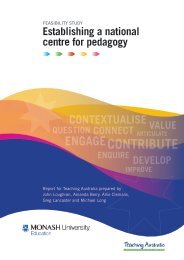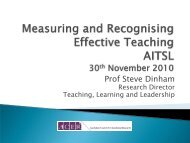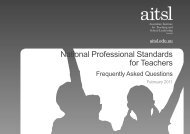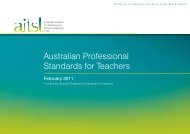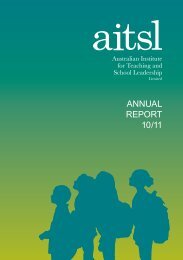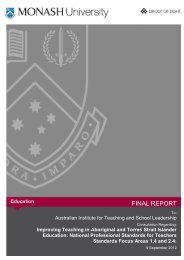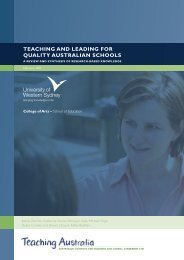Professional Learning Flagship Program: Leading Curriculum Change
Professional Learning Flagship Program: Leading Curriculum Change
Professional Learning Flagship Program: Leading Curriculum Change
You also want an ePaper? Increase the reach of your titles
YUMPU automatically turns print PDFs into web optimized ePapers that Google loves.
<strong>Curriculum</strong> change: Implications for leadershipUnderstanding the process of curriculum change is necessarily based on concepts of the natureof curriculum. Hamilton’s claim that, ‘To create a curriculum is to systematise stored-up humanexperience’, is deceptive in its simplicity. A more comprehensive view of the curriculum process is onein which valued forms of knowledge are interpreted and reinterpreted through processes of conception,translation, production, and implementation (Gilbert 2010). Such a view is elaborated by Moreno:<strong>Curriculum</strong> is a socio-historical construction which is expressed through general systems ofknowledge characterization and hierarchy; these systems are in turn translated and transformedinto legislative and administrative regulations, academic achievement standards, textbooksand teaching aids, and the practice of teaching and learning in classrooms and schools(Moreno 2006, p. 195).This somewhat linear view needs to be combined with the recognition that curriculum specificationsare articulations of meanings in social practices. As Muller points out, this process does not ‘proceedor progress seamlessly nor is it an aggregate of incremental steps’; rather, ‘The embodiment in thecurriculum of the values and practices of any particular group is the result of a process of struggle,usually symbolic, although it is always also related to the broader field of power in society’ (Muller 2000pp. 10, 11). To see the curriculum in this way is to recognise that curriculum change is a process whichlinks to broader social contexts, and which calls up deep-rooted questions about school and society,issues recognised in the references to globalisation and technological, social and environmental changein The Shape of the Australian <strong>Curriculum</strong> (Australian <strong>Curriculum</strong>, Assessment and Reporting Authority(ACARA) 2010, p. 5).The challenge of curriculum changeThe Australian curriculum is characterised in The Shape of the Australian <strong>Curriculum</strong> (ACARA 2010,p. 25) as a dynamic and futures-oriented document subject to ‘ongoing monitoring and review’, andupdating in the light of ‘review and evaluation data; new national and international knowledge andpractice about learning, teaching, curriculum design and implementation; and contemporary researchin discipline and cross-discipline areas’. Consequently, curriculum change is not a process limited to aperiod of time, but an ongoing and necessary part of the routine practice of schools.Observers have a generally pessimistic view of the experience of curriculum reform (Leithwood,Jantzi and Mascall 2002; McDonald 2003), and it is hard to deny McCulloch’s claim that ‘longerterm curriculum reform has generally failed to generate educational change of a fundamental kind’(McCulloch 1998, p. 1203). Some commentators have pointed to curriculum change as an erratic orfortuitous process dominated by fads and pendulum-like swings from one ideology or theory to another(Good, Clark and Clark 1997; Ravitch 2001).The range of factors which affect the success of curriculum implementation is as broad as educationitself (Sims and Sims 2004; Smith 2008). Table 1 from Altrichter (2005, p. 8) illustrates this range.Ellsworth has identified various causes of resistance to change, including cultural, social, organisationaland psychological barriers (Ellsworth 2000). McDonald reviewed three models of curriculum reform,the top-down approach of the ‘teacher proof’ curricula of the 1960s and 1970s (reappearing in somerecent standards bases approaches), the bottom-up approach of school-based curriculum developmentand the action research movement, and more recent approaches through collaborative partnerships ofschools, professional associations and other stakeholders (McDonald 2003). McDonald suggests thatthese approaches are limited in their modernist assumptions about knowledge and the role of studentsas consumers in a regulated institutional order, and that a more flexible and open approach is needed.An OECD analysis of curriculum reform in a range of countries identified a similar dichotomy which… reveal rather contradictory conclusions about the systemic reform endeavour. On the one hand,they reinforce the idea of the inter-connectedness of the different elements. On the other, some<strong>Professional</strong> <strong>Learning</strong> <strong>Flagship</strong> <strong>Program</strong>: <strong>Leading</strong> <strong>Curriculum</strong> <strong>Change</strong>: Literature Review 2




